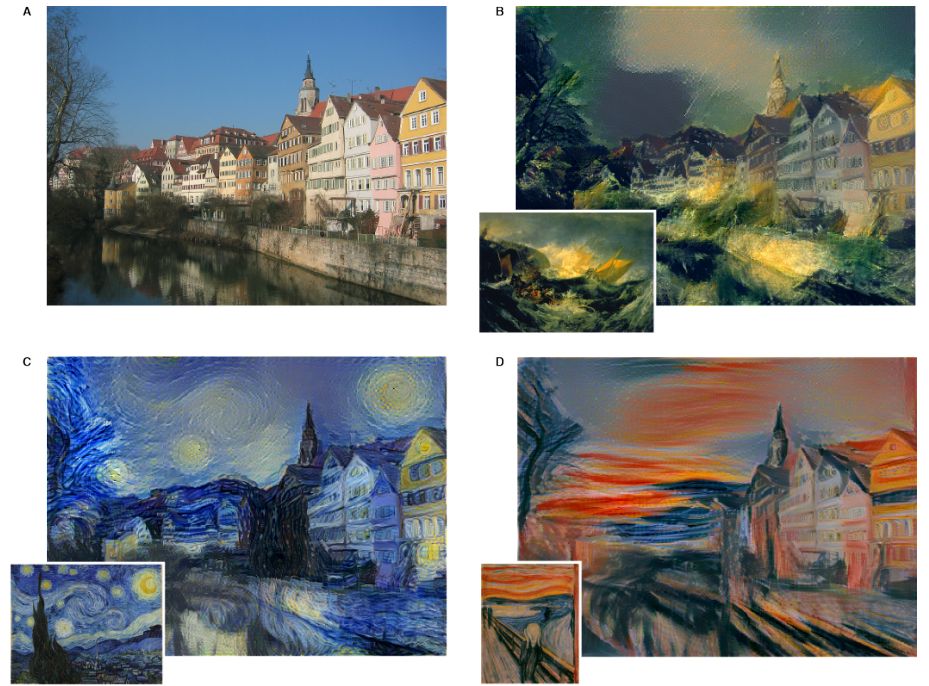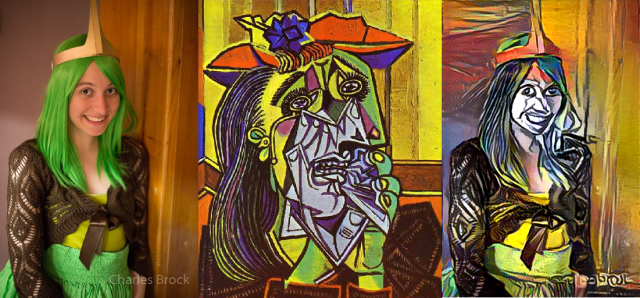Neural networks are no stranger to the art world. These networks are used in works such as Ralf Baeker’s, Rechnender Raum (Computing Space) (1) and SymbioticA’s MEART – The Semi-Living Artist. (2) Neural networks are essentially programs that mimic the human brain when it comes to problem-solving. In other words, it’s a system or network that learns from its mistakes. The DeepArt.io algorithm developed by Leon Gatys, Alexander Ecker and Matthias Bethge uses neural networks a little differently by creating stylized versions of images rather than solving a complex problem. Their web-based application is a free-to-use or “open sourced” program that has been trained to not only recognize objects and textures but also paintings, painting styles, and the artists associated with those styles. It acts as a filter for photos and this filter essentially turns your photos into paintings in the style of the famous artist. (3) Below, a photograph of Neckarfront in Tübingen, Germany (A) has been transformed into images in the styles of Turner (B), Van Gogh (C), and Munch (D). According to the Google AI Blog, “This work is considered a breakthrough in the field of deep learning research because it provided the first proof of concept for neural network-based style transfer.”(4)

DeepArt.io works by uploading a photo to the deep style generator and uploading an image of a painting or other work that you want the photo to be styled in. The program takes these two images and re-creates the reference photo in the style of the other image. (5) This algorithm is advertised as an expressionistic tool for people and artists alike to create and share their digital paintings without requiring any painting skills or artistic skills. (6) However, could one consider this impressionistic program “cheating”? The answer is yes, although this is no more “ cheating” than Photoshop. This takes a similar approach to editing photos as does Photoshop and takes it to another level by being an open sourced program that uses machine learning to create and edit. This algorithmic code has given rise to a community of Deep style creators all over the internet and it falls in line with the culture of communal art, yet all works are individualized based on choices made by the participants.(7) Perhaps the “art” operates at multiple levels: the art of creating the algorithm itself and the art of transforming a mundane image into another style of one’s choice.

Lastly, below are links if you’d like to create one yourself:
https://deepdreamgenerator.com/
https://www.makeuseof.com/tag/create-neural-paintings-deepstyle-ubuntu/
Sources:
1. Ciechowska, Zofia. “Rechnender Raum (Computing Space).” Art and Electronic Media Online Companion, 24 Mar. 2010, artelectronicmedia.com/artwork/rechnender-raum-computing-space.
2. Smeddinck, Jan. “MEART – SymbioticA’s Fish & Chips.” Art and Electronic Media Online Companion, 17 July 2009, artelectronicmedia.com/artwork/meart-symbioticas-fish-chips
3. 1. French, Aslan. “How Artists Can Use Neural Networks to Make Art.” ART + Marketing, ART + Marketing, 7 Mar. 2017, artplusmarketing.com/how-artists-can-use-neural-networks-to-make-art-714cdab53953
4. Vincent Dumoulin, Jonathon Shlens and Manjunath Kudlur, Google Brain Team, “Supercharging Style Transfer,” Google AI Blog, Wednesday, October 26, 2016
https://ai.googleblog.com/2016/10/supercharging-style-transfer.html
5. Gatys, Leon, et al. “A Neural Algorithm of Artistic Style.” Journal of Vision, vol. 16, no. 12, 2016, p. 326., doi:10.1167/16.12.326
6. Gatys, Leon, et al. “About.” Become a Digital Artist, 2017, deepart.io/page/about/
7. Infante, Andre. “Create Your Own ‘Neural Paintings’ with DeepStyle & Ubuntu.” MakeUseOf, MakeUseOf, 16 Sept. 2015, www.makeuseof.com/tag/create-neural-paintings-deepstyle-ubuntu/
